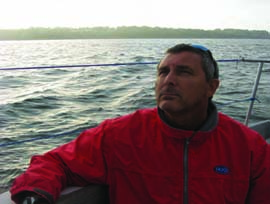
Tiverton, Rhode Island is a quiet village on the east bank of the Sakonnet River, opposite Portsmouth. If you cross the Sakonnet River Bridge, you’re driving over and through Tiverton. It has some nice old Victorian houses, a convenience store and a few boatyards south of the bridge. On the north side, there are mixed businesses and houses en route to Fall River the back way.
Tiverton is the kind of place you have to go to, to get to. It’s not commonly mentioned in the same sentence as Newport, Portsmouth or Bristol when it comes to hotbeds of sailing and related marine technology, but it does have its moments. It is after all in Rhode Island, it’s on the water, the local high school has boat building and electronics classes, and there’s a good junior sailing program at Tiverton Yacht Club.
Around midnight on a Friday in late August, an astute observer might have seen a group of college kids descend on Sakonnet Point, some five miles south of Tiverton. The long body bag-like thing they carried from their car was not Jimmy Hoffa but the culmination of three years of work, testing, planning and frustration.
In 2010, half a dozen mates were hanging out in the Tiverton garage of one of their number and, with another mate studying in Spain, they had the idea to send him a message in a bottle. As occasionally happens, this idea went pretty crazy pretty quickly. The upshot was the idea to build an autonomous vehicle to motor over to Spain. As I write this in early September, the Scout Autonomous Vehicle has broken the record for distance traveled for such vessels and is over 600 miles offshore en route to the south cost of Spain.
Over three years, the core group (all college students) comprising Dylan Rodriguez, brothers Dan and Mike Flanigan, Max Kramers, Ryan Muller, Brendan Prior and David Pimental conceived of the idea, planned it out, designed the boat (starting with two 24-inch models), broke lots of parts and systems, built the boat, designed and built the tracking and solar powering systems and heaven knows what else that ended up being the Scout Autonomous Vehicle. Scout is a 12-foot long boat with the general look of a Volvo 70, with a keel to recover from being capsized by waves, a rudder, an electric motor, two lithium-ion batteries – one for comms and one for powering the motor and steering. They wrote the software for all the electronics and generally did everything to design, build and launch this boat.
I was introduced to the Scout Project by an invitation from Brendan to “like” it on Facebook (search “Scout – the Autonomous Transatlantic Robotic Vehicle”). After looking around the FB page and their website (gotransat.com), I called Brendan to discuss this adventure. He said Scout started as an idea but has evolved into the actual boat, and that there are some business-like ideas floating around inside the project garage. For instance, the position information is transmitted back to them by satellite phone. There is, of course, no space on Scout for a phone handset and keyboard, so they managed to source the interior electronics for a sat phone, and designed the software that connects the GPS to the phone chip and tells it to send information every 20 minutes. This sourcing alone required over 200 phone calls. There is in fact nothing off the shelf on the boat, except the hull materials that were generously donated by their principal sponsor, Jamestown Distributors in Bristol. Early on, several evenings were consumed with discussions on what the hull needed to look like, in order to operate in the ocean and carry all the “stuff.” After these questions were settled, Max Kramers set to designing the hull. Max is in Engineering school in Spain and has a bit of experience with composites and design. His father, Dirk, is one of the lead engineers at Oracle Team USA. When the design was completed, the drawings were sent via email to Dan Flanigan, a Civil Engineering student at Bucknell University. Dan has a history of building things including a stripplanked kayak, so he became “the boat builder” and started to build the mold for Scout. This was subsequently carried to Tiverton on top of Dan’s car and introduced to the garage floor. While this was going on, Dylan, an Engineering student at Worcester Polytechnic Institute, and Mike, an Aerospace Engineering student at Notre Dame, started work on the electronics package. It is to be remembered that this project was undertaken by half a dozen lads, all at university in different parts of the country. Over time, the project developed with funding from a host of Tiverton residents and support from parents and friends. All of which led to the midnight rendezvous at Sakonnet Point.
What happens when Scout gets to Spain? They will fly over, pick it up, ship it back and do something else…maybe developing some of those ideas floating around the garage. Whatever happens to Scout, it’s obvious that there are young people out there with a sense of adventure and the desire to try something new, figure things out, actually build things and make it all work. I find it encouraging that these characteristics are alive and well, at least in Tiverton.
Australian born, Joe ‘Coop’ Cooper stayed in the US after the 1980 America’s Cup where he was the boat captain and sailed as Grinder/Sewer-man on Australia. His whole career has focused on sailing, especially the short-handed aspects of it. He lives in Middletown, RI where he coaches, consults and writes on his blog, joecoopersailing.com, when not paying attention to his wife, teenage son, dog, two cats and several, mainly small, boats.




